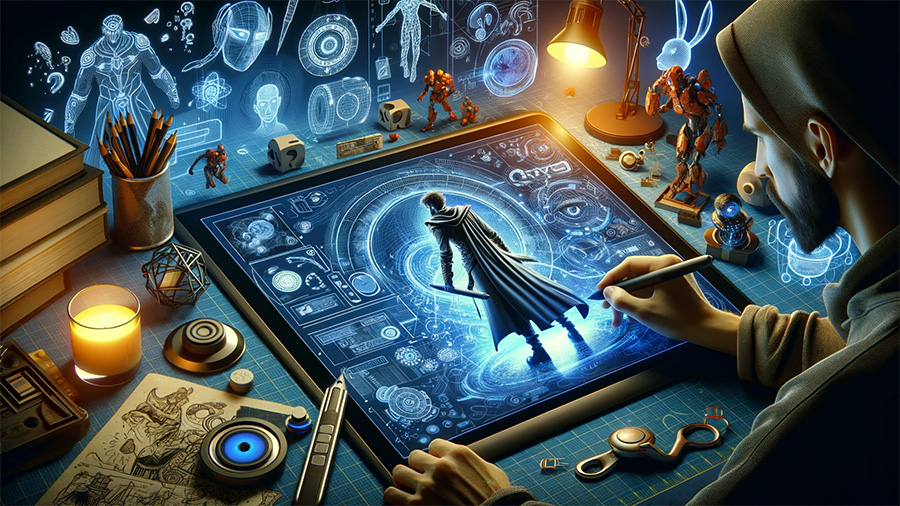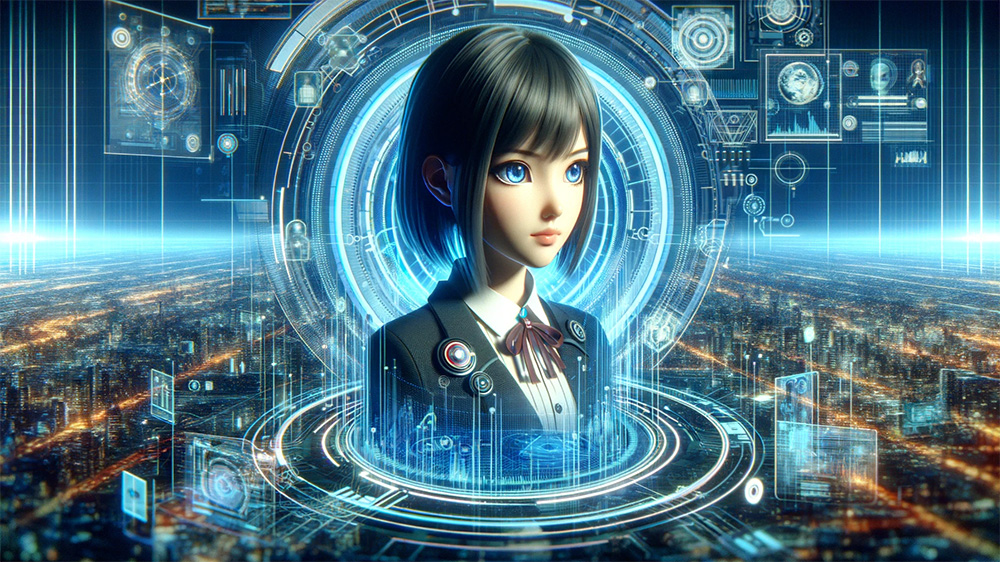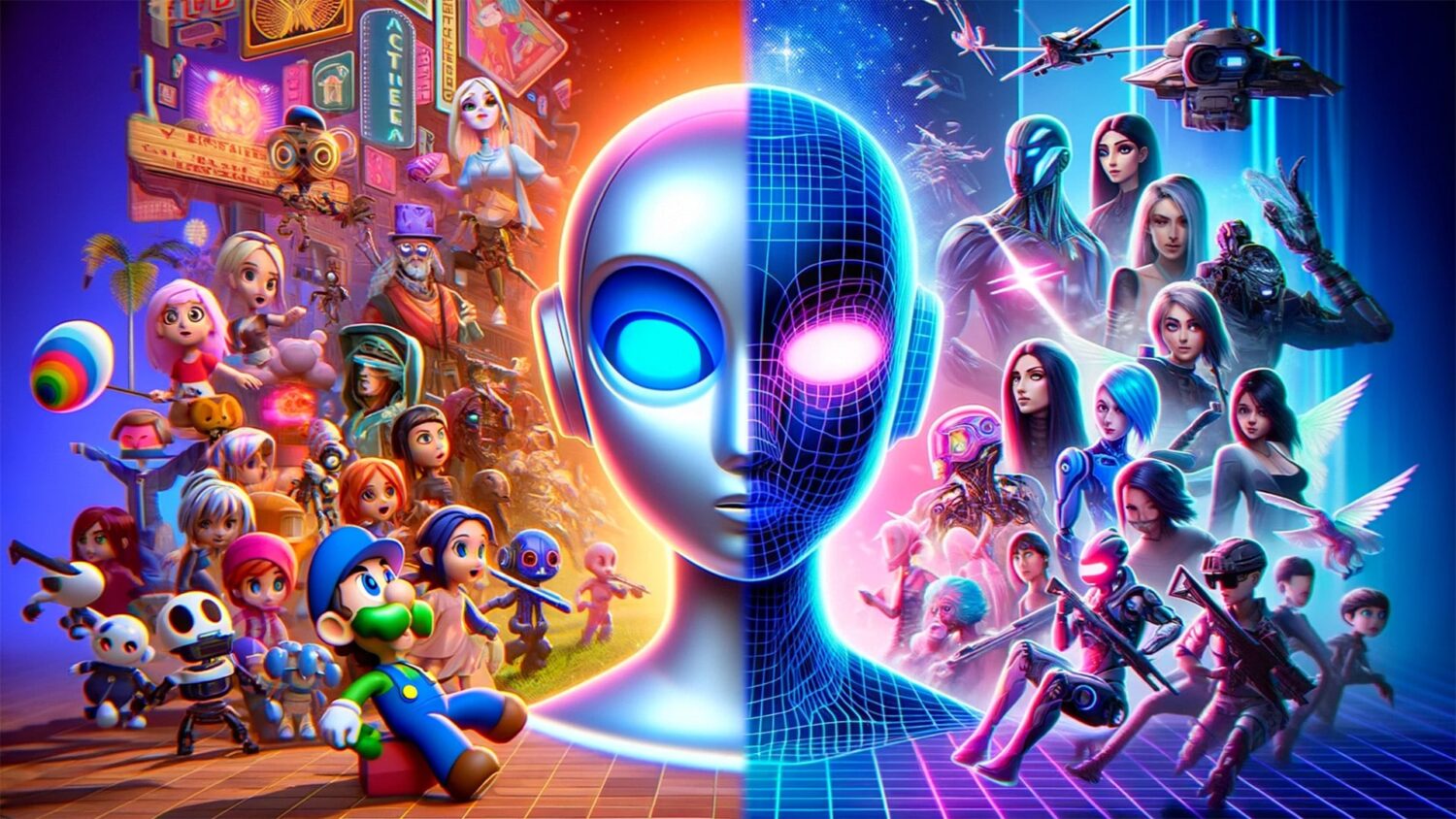There is something about a well-designed character that draws you in right away. Everything about them, from their unique looks to the clothes and items they wear, is tailored to show who they are, where they come from, and what their role is in the story. The trick is in getting the perfect mix between what’s known and what’s new so that characters feel new and interesting while still making it easy to relate to them.
But, how do you make this work in animation and games? First, you need to learn how the character can be your ticket to success.
Character Design: The Foundation of Your Story
It’s the job of character designers to make sure that the story has interesting and emotional individuals, both the main character and their entourage.
A great character goes beyond their looks, though; they have a complex psychological makeup that drives their actions, goals, and interactions. Their intelligence, humor, weakness, or authority are all parts of their personalities that make them relatable. We feel more connected to heroes and villains when they have flaws and traits that make them seem real and wounded. For character designers, the secret is creating characters with distinct backstories, limitations, and looks that stick with you long after you’ve interacted with them.
One of the biggest examples is the Spiderman character in movies, animations, games, and comics. His iconic red and blue suit, sense of humor, sincerity, and of course, the webs make him easy to remember even 50 years later.
Character Design: Adapting to Animation and Video Games
Character design is surely a fundamental element in the success of any animation or video game. However, the exact mechanics can be different based on the medium. For example, in video games and animation, you have to consider factors such as the character’s movements, voice, and intonation. In contrast, designing characters for the Metaverse involves focusing on interactivity and immersion. For instance, a Metaverse character might be designed with highly realistic features and responsive AI, allowing for real-time interaction and personalization by users in the virtual world.
Overall, a solid character can breathe life into any animation, or video game.
Character Design in Animation: Living the Story
Some people say that animation without a strong character design is like a body without a soul. Without strong character design, animation can’t even come close to living-action movies. It’s easier for people to connect with animated characters than the ones in a movie because in a movie, a part of your judgment always relates to the actor’s real-life personality and stature.
Plus, in a movie, the director may be limited to the actor’s talent, physical abilities, and the surrounding environment to instill a certain feeling in the viewer. But, animation gives you far more creative freedom to engage the audience as much as possible.
For a character to be memorable, their design must be top-notch. The better people remember the animation, game, or comic book for its character, the more money it can make from ticket sales, merchandise, and advertising.
Character Design in Video Games: Maximum Engagement
The character is the backbone of any successful video game because the player lives through the character and experiences their journey.
Players interact with video games through characters. As the game goes through various phases, the player gets to experience the feelings of the character first-hand. They are needed to make the different parts of the story come alive.
The best games are the ones that fit the player’s fears and ambitions. When players connect with the character’s journey, they become personally invested in the game because it’s not just entertainment, it’s a personal quest.
Character Dominating a Franchise: Two Famous Cases
Fantastic character designs have the power to do more than just improve a product’s aesthetic; they can launch entire franchises, fund businesses, and even alter the course of an entire sector.
Mickey Mouse, Monster Inc.’s Sully & Mike, and Mario are just a few examples that show how good character design can affect the creators, the audience, and the end product. Here are some famous cases of great character design.
Monsters, Inc.
Modern animation and Pixar’s unforgettable characters have made the studio famous. Monsters, Inc. is a prime animation that shows how good Pixar is at making digital characters. Two monsters named Sulley and Mike go on a quest in this film. They work for a corporation that turns the cries of children into electricity for their town.
A lot of thought went into making the characters, from their hair and facial movements to their unique colors and physical features like Sully’s fur. Such a level of quality has made this animation win many prestigious awards.

Horizon’s Aloy
In the Horizon game series, Aloy is the strong female protagonist. Her honesty, brilliance, and humor make her a very relatable character. She is part of a long line of powerful women figures in science fiction. And because of good design work from a great artist, she has a memorable look too. Everything about her, from her clothes and weapons to her hairstyle and posture is a great fit for the game’s post-apocalyptic vibe.

Some Design Rules
Creating a living, breathing character requires careful planning and execution of visual elements. Before you can get to the illustration, you need to define the character’s traits, background, limitations, and other non-visual elements. Here are some of those elements.
Do Your Homework
If you go and read any posts on character design, you’ll know that research is the first step because it defines the pre-production phase of your important creative work. Before you can start to create, you need to have a basic idea of your project so you can direct your imagination in the right way.
Instead of just surfing the web, use your critical thinking skills to figure out why some characters are great while others fail. Look at character designs from different games, animations, and comic books, and think about why you like certain things about them. If you want to keep your mind like a library, you need as many reference books as possible.
Define the Audience
The audience is everything to character design because they will judge the success or failure of your work. When making artistic choices, it’s important to know what your audience likes and doesn’t like.
For example, the language, personality traits, storyline, and overall look of a kid’s animation character are far different from the protagonist in a video game like GTA.
Focus on the Personality
Personality is the epicenter of the character because everything from the storyline and limitations to facial expressions and body language goes back to the personality traits. Once you define your audience and get a basic idea of the storyline, you need a personality type that can serve the purposes of the story.
The way a character dresses, their height, their voice, and how they look all need to fit a certain geographical region. Finding the region can help you with defining other elements of the character.
Set A backstory & Arc
People yearn for positive change in their own lives, so they always relate to characters that grow and develop over time. A character who has a strong, established background is easy to remember. Of course, this change has to happen over an arc that clearly outlines the physical and emotional milestones of the journey. Spend some time on this, and you’ll be well on your way to making something outstanding.
Define the Limitations
Limitations play a huge part in the storyline. When a character has limitations or obstacles, it can make the journey more personal and familiar. For example, the character may face family problems, struggle with bullies at school, try to win someone’s heart or other relatable challenges.
People love stories when a character rises from the ashes to overcome the demons as they look for the same thing in their own lives. It can become even more personal in video games because the player steps into the identity of the in-game character and experiences this first-hand.
Character Design in the Digital Age

Embracing AI in Character Design
The evolution of character design has taken a futuristic turn with the advent of Artificial Intelligence (AI). AI in character design is not just about automating the creative process; it’s about augmenting the creativity of human designers. AI tools can analyze vast amounts of data on character trends, audience preferences, and successful design elements, offering insights that might take humans much longer to identify.
AI can also generate preliminary designs based on specified parameters, allowing designers to explore a wider range of options and focus on refining the best concepts. In addition, AI’s predictive models can help in understanding how audiences might react to a character, aiding in creating more relatable and engaging designs.
Character Design for the Metaverse
The Metaverse, a collective virtual shared space created by the convergence of virtually enhanced physical reality, augmented reality (AR), and the internet, offers a new frontier for character designers. In this realm, characters are not just static or scripted entities; they are interactive avatars that represent users or AI entities.

Interactivity and Immersion: In the Metaverse, character design goes beyond visual appeal. It involves creating an immersive experience where characters can interact with users and the environment in a realistic manner. The design must account for 3D modeling, realistic movement, and interaction capabilities.
Personalization and Customization: Users in the Metaverse often seek a personalized avatar that represents their identity or desired persona. Character designers must create flexible templates that allow for high levels of customization, enabling users to alter appearances, outfits, and accessories.
Consistency Across Platforms: Characters designed for the Metaverse must maintain consistency across different platforms and environments. This requires a deep understanding of various virtual spaces and the technical specifications of each.
Ethical Considerations: Designing characters for an immersive world like the Metaverse also brings new ethical considerations. Designers must be mindful of creating inclusive and diverse characters, avoiding stereotypes, and ensuring that their designs do not inadvertently promote negative behaviors.
Conclusion
The essence of character design, whether for traditional mediums like games, animations, or for cutting-edge realms like AI and the Metaverse, lies in its power to connect with audiences on a profound level. While audio-visual effects and background designs play significant roles, the heart of any story is its characters. Traditional design principles remain foundational, focusing on personality, backstory, and audience engagement. However, the incorporation of AI offers a new dimension of data-driven insights and creativity, enhancing the depth and relatability of characters. Meanwhile, the Metaverse introduces a paradigm shift where characters are not just passive elements but interactive and customizable avatars, bridging the gap between storytelling and personal identity. This evolving landscape of character design, blending artistry with technology, heralds a new era of immersive storytelling and audience engagement, creating experiences that resonate deeply both in virtual worlds and beyond.
We’re ready to take this journey with you too. Just get in touch and let’s start!

